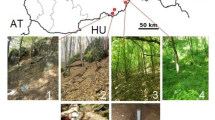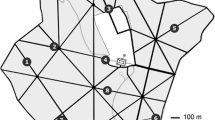Abstract
The attractiveness of ultra high release ethanol lures to ambrosia beetles in Slovakian oak forests was tested from 2010 to 2012. A total of 24,705 specimens were captured during this three year period with Xyleborinus saxesenii (Ratzeburg, 1837) representing 49.28% (12,174 specimens) of the total. Other dominant species captured in the traps were Anisandrus dispar (F., 1792) (27.84%), Xyleborus monographus (F., 1792) (9.72%) and Trypodendron signatum (F., 1792) (6.04%). During this experiment, Xylosandrus germanus (Blandford, 1894) was detected for the first time in Slovakia with an increase in capture each year (19, 40 and 77 specimens, respectively). Flight period for ambrosia beetles in Slovakia occurs from the beginning of April through the end of September. This is the first time that ethanol baited traps were deployed in Slovakian oak forests and the lures were an effective tool for monitoring native and non-native ambrosia beetles.
Similar content being viewed by others
References
Bambara S., Stephan D. & Reeves E. 2008. Granulate [Asian] ambrosia beetle trapping. www.ces.ncsu.edu/depts/ent/notes/O&T/trees/note122/note122.html (accessed 16.5.2014)
Bouget C. & Noblecourt T. 2005. Short-term development of ambrosia and bark beetle assemblages following a windstorm in French broadleaved temperate forest. J. Appl. Entomol. 129(6): 300–310. DOI: 10.1111/j.1439-0418.2005.00970.x
Bullas-Appleton E., Kimoto T. & Turgeon J.J. 2014. Discovery of Trichoferus campestris (Coleoptera: Cerambycidae) in Ontario and first host record in North America. Can. Entomol. 146: 111–116. DOI: http://dx.doi.org/10.4039/tce.2013.61
Cade S.C., Hrutfiord B.F. & Gara R.I. 1970. Identification of a primary attractant for Gnathotrichus sulcatus isolated from western hemlock logs. J. Econ. Entomol. 63(3): 1014–1015.
Cossins E.A. 1978. Ethanol metabolism in plants, pp. 169–202. In: Hook D.D. & Crawford R.M.M. (eds), Plant Life in Anaerobic Environments, Ann Arbor Science Publisher Inc, Michigan, 564 pp. ISBN: 0250401975, 9780250401970
Coutts M.P. & Armstrong W. 1976. Role of oxygen transport in the tolerance of trees to waterlogging, pp. 361–385. In: Cannell M.G.R. & Last F.T. (eds), Tree Physiology and Yield Improvement, Academic Press, New York, 567 pp. ISBN: 0121587509, 9780121587505
Coyle D.R., Booth D.C. & Wallace M.S. 2005. Ambrosia beetle (Coleoptera: Scolytidae) species, flight, and attack on living eastern cottonwood trees. J. Econ. Entomol. 98(6): 2049–2057. PMID: 16539132
Crawford R.M.M. & Baines M.A. 1977. Tolerance of anoxia and metabolism of ethanol in tree roots. New Phytol. 79: 519–526. DOI: 10.1111/j.1469-8137.1977.tb02236.x
Flint M.L., Liu D., Lee J.C., Beiriger R., Penrose R.L., Bright D.E. & Seybold S.J. 2007. Responses of red haired pine bark beetle (RPBB), Hylurgus ligniperda, and associated subcortical Coleoptera to host volatiles in southern California. http://esa.confex.com/recording/esa/2007/pdf/39845/b93fd97f75745ee041d14a6604829248/paper31213_1.pdf (accessed 16.5.2014)
Führer E. 1998. Oak decline in central Europe: A synopsis of hypotheses, pp. 7–24. In: McManus M.L. & Liebhold A.M. (eds), Proceedings: Population Dynamics Impact, and Integrated Management of Forest Defoliating Insects, USDA Forest Service general technical report, Hamden, Connecticut, 352 pp.
Galko J. 2013. First record of the ambrosia beetle, Xylosandrus germanus (Blandford, 1894) (Coleoptera: Curculionidae, Scolytinae) in Slovakia. Lesn. Cas. — For. J. 58(4): 279.
Graham K. 1968. Anaerobic induction of primary chemical attractancy for ambrosia beetles. Can. J. Zool. 46(5): 905–908. DOI: 10.1139/z68-127
Grégoire J.C., Piel F., De Proft M. & Gilbert M. 2001. Spatial distribution of ambrosia-beetle catches: A possibly useful knowledge to improve mass-trapping. Integr. Pest. Manage. Rev. 6(3–4): 237–242. DOI: 10.1023/A:1025723402355
Humble L.M. 2001. Invasive bark and wood-boring beetles in British Columbia, Canada, pp. 69–77. In: Alfaro R.I., Day K.R., Salom S.M., Nair K.S.S., Evans H.F., Liebhold A.M., Lieutier F. Wagner M., Futai K. & Suzuki K. (eds), Protection of World Forests: Advances in Research, Proceedings: XXI IUFRO World Congress, August 7–12, 2001, Kuala Lumpur, Malaysia. IUFRO Secretariat, Vienna, IUFRO World Series Vol. 11, 253 pp.
Humble L.M., John E., Smith J., Zilahi-Balogh G.M.G., Kimoto T. & Noseworthy M. 2010. First records of the banded elm bark beetle, Scolytus schevyrewi (Coleoptera: Curculionidae: Scolytinae), in British Columbia. J. Entomol. Soc. British Columbia 107: 21–24.
Kelsey R.G. & Joseph G. 2001. Attraction of Scolytus unispinosus bark beetles to ethanol in water-stressed Douglas-fir branches. For. Ecol. Manage. 144(1–3): 229–238. DOI: 10.1016/S0378-1127(00)00387-X
Knížek M. & Beaver R. 2004. Taxonomy and systematics of bark and ambrosia betles, Chapter 5, pp. 41–54. In: Lieutier F., Day K.R., Battisti A., Grégoire J.-C. & Evans H.F. (eds), Bark and Wood Boring Insects in Living Trees in Europe, a Synthesis, Springer, Amsterdam, 569 pp. ISBN: 978-1-4020-2240-1
Klimetzek D., Köhler J., Vité J.P. & Kohnle U. 1986. Dosage response to ethanol mediates host selection by “secondary” bark beetles. Naturwissenschaften 73(5): 270–271. DOI: 10.1007/BF00367783
Kottek M., Grieser J., Beck C., Rudolf B. & Rubel F. 2006. World Map of Köppen-Geiger Climate Classification updated. Meteorol. Z. 15: 259–263. DOI: 10.1127/0941-2948/2006/0130.
Lakatos F. & Kajimura H. 2007. Occurrence of the introduced Xylosandrus germanus (Blandford, 1894) in Hungary — a genetic evidence (Coleoptera: Scolytidae). Folia Entomol. Hung. — Rovartani Közlemenyek 68: 97–104.
Leontovyč R. & Čapek M. 1987. Eichenwelken in der Slowakei. Österr. Forstzg. 98(3): 51–52.
Lindelöw A., Eidmann H.H. & Nordenheim H. 1993. Response on the ground of bark beetle and weevil species colonizing conifer stumps and roots to terpenes and ethanol. J. Chem. Ecol. 19(7): 1393–1403. DOI: 10.1007/BF00984884
Lindgren B.S. 1983. A multiple funnel trap for scolytid beetles (Coleoptera). Can. Entomol. 115(3): 259–273. DOI: http://dx.doi.org/10.4039/Ent115299-3
Mani E., Remund U. & Schwaller F. 1992. Attack of the bark beetle, Xyleborus dispar F., (Coleoptera: Scolytidae) in orchards and vineyards. Importance, biology, flight observations, control, development and use of an efficient ethanol trap. Acta Phytopathol. Entomol. Hung. 27(1–4): 425–433.
Markalas S. & Kalapanida M. 1997. Flight pattern of some Scolytidae attracted to flight barrier traps baited with ethanol in an oak forest in Greece. J. Pest. Sci. 70(3): 55–57. DOI: 10.1007/BF01996922
Miller R.D. & Rabaglia J.R. 2009. Ethanol and (−)-α-pinene: Attractant kairomones for bark and ambrosia beetles in the southeastern US. J. Chem. Ecol. 35(4): 435–448. DOI: 10.1007/s10886-009-9613-9
Moeck H.A. 1970. Ethanol as the primary attractant for the ambrosia beetle Trypodendron lineatum (Coleoptera: Scolytidae). Can. Entomol. 102(8): 985–995. DOI: http://dx.doi.org/10.4039/Ent102985-8
Montgomery M.E. & Wargo P.M. 1983. Ethanol and other host-derived volatiles as attractants to beetles that bore into hardwoods. J. Chem. Ecol. 9(2): 181–190. DOI: 10.1007/BF00988035
Naik V., Fiore A., Horowitz L., Singh H.B., Wiedinmyer C., Guenther A., Gouw J.A., Millet D.B., Goldan P.D., Kuster W.C. & Goldstein A. 2010. Observational constraints on the global atmospheric budget of ethanol. Atmos. Chem. Phys. 10: 5361–5370. DOI: 10.5194/acp-10-5361-2010
Noseworthy M.K., Humble L.M., Sweeney J., Silk P. & Mayo P. 2012. Attraction of Monarthrum scutellare (Coleoptera: Curculionidae: Scolytinae) to hydroxyl ketones and host volatiles. Can. J. For. Res. 42: 1851–1857. DOI: 10.1139/x2012-122
Oliver J.B. & Mannion C.M. 2001. Ambrosia beetle (Coleoptera: Scolytidae) species attacking chestnut and captured in ethanol-baited traps in middle Tennessee. Environ. Entomol. 30(5): 909–918. DOI: 10.1603/0046-225X-30.5.909
Pfeffer A. 1989. Kůrovcovití Scolytidae a jádrohlodovití Platypodidae. Academia, Praha, 137 pp. ISBN: 80-200-0089-5
Ranger C., Reding M., Gandhi K., Oliver J., Schultz P., Cañas L. & Herms D. 2011. Species dependent influence of (−)-α-pinene on attraction of ambrosia beetles (Coleoptera: Curculionidae: Scolytinae) to ethanol-baited traps in nursery agroecosystems. J. Econ. Entomol. 104(2): 574–579. DOI: 10.1603/EC10243
Ranger C., Reding M., Persad A. & Herms D. 2010. Ability of stress-related volatiles to attract and induce attacks by Xylosandrus germanus (Coleoptera: Curculionidae, Scolytinae) and other ambrosia beetles. Agr. For. Entomol. 12(2): 177–185. DOI: 10.1111/j.1461-9563.2009.00469.x
Reding M., Oliver J., Schultz P. & Ranger C. 2010. Monitoring flight activity of ambrosia beetles in ornamental nurseries with ethanol-baited traps: Influence of trap height on captures. J. Environ. Hort. 28(2): 85–90.
Roling M.P. & Kearby W.H. 1975. Seasonal flight and vertical distribution of Scolytidae attracted to ethanol in an oak-hickory forest in Missouri. Can. Entomol. 107(12): 1315–1320. DOI: http://dx.doi.org/10.4039/Ent1071315-12
Salom S.M. & McLean J.A. 1990. Flight and landing behavior of Trypodendron lineatum (Coleoptera: Scolytidae) in response to different semiochemicals. J. Chem. Ecol. 16(8): 2589–2604. DOI: 10.1007/BF01017481
Schwenke W. 1974. Die Forstschädlinge Europas. Ein Handbuch in 5 Bänden. Band 2. Käfer, Verlag Paul Parey, Hamburg. ISBN: 3-490-11016-1
Sonesson K. & Drobyshev I. 2010. Recent advances on oak decline in southern Sweden. Ecol. Bull. 53: 197–207.
Sweeney J., De Groot P., Humble L.M., MacDonald L.M., Price J., Mokrzycki T. & Gutowski J.M. 2007. Detection of woodboring species in semiochemical-baited traps, pp. 139–144. In: Evans H.F. & Oszako T. (eds), Alien Invasive Species and International Trade, Forest Research Institute, Warsaw, 179 pp. ISBN: 978-83-87647-64-3
Vrkočová P., Valterová I., Vrkoč J. & Koutek B. 2000. Volatiles released from oak, a host tree for the bark beetle Scolytus intricatus. Biochem. Syst. Ecol. 28(10): 933–947. DOI: 10.1016/S0305-1978(00)00042-9
Zhang Q.H., Tolasch T., Schlyter F. & Francke W. 2002. Enantiospecific antennal response of bark beetles to spiroacetal (E)-conophthorin. J. Chem. Ecol. 28(9): 1839–1852. DOI: 10.1023/A:1020569303433
Zhang Q.H., Schlyter F. & Birgersson G. 2012. 2-methyl-3-buten-2-ol: a pheromone component of conifer bark beetles found in the bark of nonhost deciduous trees. Psyche J. Entomol. 2012, Article ID 414508, 7 pp. DOI: 10.1155/2012/414508
Author information
Authors and Affiliations
Corresponding author
Rights and permissions
About this article
Cite this article
Galko, J., Nikolov, C., Kimoto, T. et al. Attraction of ambrosia beetles to ethanol baited traps in a Slovakian oak forest. Biologia 69, 1376–1383 (2014). https://doi.org/10.2478/s11756-014-0443-z
Received:
Accepted:
Published:
Issue Date:
DOI: https://doi.org/10.2478/s11756-014-0443-z




